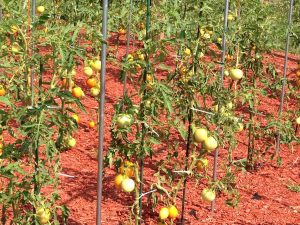Q. I live on 6.5 acres of land that is completely surrounded by a few varieties of tall pine trees, over a hundred of them. When we moved here 4 years ago, the trees were very full and looked very healthy; however, this past year or two I have noticed many of them seem to be losing their limbs, starting at the bottom, and it seems to be spreading. We trimmed the trees that line the driveway from the base to about 10 feet to get rid of the dead branches. Who could I call that is knowledgeable to come and take a look at my property to look at these trees and maybe give us a recommendation to cure this, if it can be. These trees are beautiful and give us all our privacy. J.H., Valparaiso, Indiana
A. Pines and other conifers can lose lower limbs gradually as the trees age, possibly just from being shaded from the upper canopy as the trees mature. If the trees are planted too closely, they may also be shading each other. Windbreaks and perimeter plantings are commonly started with close spacing when the trees are young to provide quicker screening, but as the trees mature, they get too crowded. If the rest of the tree looks healthy, I would not be too concerned. But there are a number of disease and insect pests, as well as environmental and weather-related stress that can cause decline. We’ve had a few tough years – most notably the extreme heat and drought in 2012 and the brutally cold winter in early 2014.
There are several resources available to help determine the health of your trees. The Purdue Extension office in your county may be able to assist with diagnosis. Contact information is available atextension.purdue.edu/pages/CountyOffices.aspx.
The Purdue Plant and Pest Diagnostic Lab can assist with diagnosis of your trees and other plants either by digital images, live samples or both. See the website for additional information.
The Indiana Department of Natural Resources has district foresters distributed across the state who can provide technical assistance to woodland owners. Their contact information is listed at www.in.gov/dnr/forestry/4750.htm.
Q. I have a 30-year-old sugar maple tree that did not get leaves this year. It appears healthy – no sign of bugs or any other damage. The tips of the small branches appear to have little buds ready to turn into leaves – but nothing. Was the tree too damaged by the severe cold this winter and it died? Or will it live and have leaves next year? M.S., Valparaiso, Indiana
A. Unfortunately, the prognosis is not good for trees that failed to leaf out this year. Many trees across the state experienced significant dieback or death of the entire tree following this year’s harsh winter. To be certain that the tree is dead before you have it cut down, you can check the buds by cutting a few open. If they are green inside, then there is hope. If the buds are brown and dry, then it is time to remove the tree. A healthy tree would also have buds all along the twigs, not just at the branch tips.

Tomatoes dying from the bottom of the stem up. Photo Credit: Rosie Lerner/Purdue Extension
Q. My neighbors and I have a question about tomato plants. Our tomato plants have the same problem year after year, even though we rotate to a new section of earth yearly.
The problem is when tomatoes are set out for what we hope will be a good crop, the tomato plants start, grow, and start flowering and producing fruit. But at about this time, the bottom leaves and stems that do flower start to die, but the main stems of the plant are not affected, or so it seems. Eventually, this dying of leaves and stems continues up the plant slowly as the plant grows and produces fruit. The main stem generally stays green, but in later summer the whole plant will eventually die, or nearly all of it will.
I’ve heard copper sulfate or something on that order will help. Does it? Or do you know what the problem is or may be? J.D.C., DeMotte, Indiana
A. Tomatoes are plagued by a number of diseases that can cause the symptoms you’ve described. Early blight and septoria leaf spot are common fungal diseases that are particularly problematic during wet weather. Good cultural practices can help prevent or reduce infection, and there are a few fungicides (some contain copper) that can help protect uninfected foliage. But in frequent wet conditions, it is difficult to completely control. Be sure to clean up the plant debris this fall to reduce problems next year. Additional information on these tomato diseases can be found at http://www.ppdl.purdue.edu/PPDL/weeklypics/7-12-10.html and www.ipm.iastate.edu/ipm/hortnews/1996/4-26-1996/tomato.html
Q. We would like to plant a couple of deciduous trees for shade on the south side of our house. The problem is that we have a sewer line from the house to the collection box about 75 feet down the slope. What kind of trees would best serve our purpose? M.M., Hardinsburg, Indiana
A. Trees are not well suited to planting near septic or sewer lines. Roots will eventually grow well beyond the canopy dripline and can invade openings in the pipes to reach the moisture and nutrients. If space permits, you could plant trees farther away from the sewer line to provide some shade and consider smaller shrubs and/or perennials closer to the house. Purdue Extension has a publication on Landscaping Near Septic Systems with Native Plants.